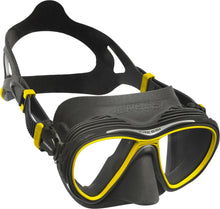
The major innovation with the quantum mask is that as well as offering enhanced downwards vision it avoids the fogging phenomenon through the internal thermoregulation of the warm, damp air exiting the nose. This air is channelled by a system of membranes set in the moulding around the eyes and nose and deviating the flow towards the rubber skirt rather than the lenses. The external part of the skirt features a cooling system composed of two small heat exchangers that act as radiators. The effect is that the temperature inside mask drops, coming closer to the external temperature and the droplets of humidity are trapped before the air reaches the lenses, preventing them from fogging up. Despite the presence of the small internal membranes deviating the air flow and the external heat exchangers, the body of the quantum mask is nonetheless compact and represents the most advanced design offered on the underwater vision market. The lenses are not treated chemically and it should be remembered that when the mask is new, as is the case with all masks, we advise you to clean the lenses carefully with toothpaste or dishwashing detergent, or simply use a lighter to burn away all volatile materials and dust that may have collected on the glass. It is also always useful to use saliva as a surfactant before every dive.









